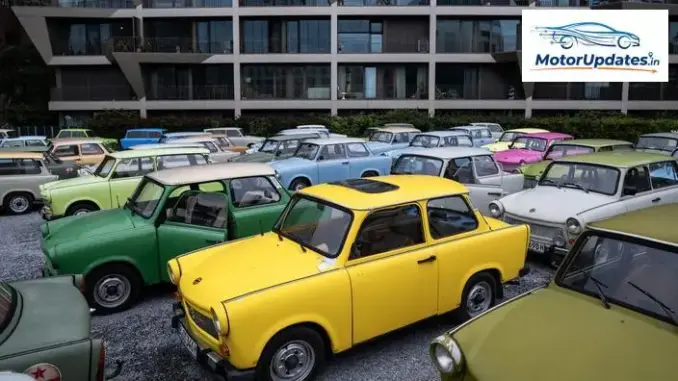
As Germany marks the 35th anniversary of its reunification, the number of “Trabis,” the communist-era cars whose production stopped in 1991, is steadily rising.
Basic design, cramped interior and bluish exhaust fumes… The Trabant was mocked as one of the worst cars ever made. Today, the vehicle that symbolizes East Germany still has devoted fans and stubbornly refuses to vanish. As Germany on Friday celebrates 35 years since reunification and therefore the end of the GDR, the number of “Trabis” on the roads is increasing.
According to the Federal Motor Transport Authority (KBA), some 40,800 Trabants are registered in the country, compared with about 33,000 in 2010. Glenn Kuschan, 58, runs a garage south of Berlin. He counts several Trabant owners among his clients. He himself owns 23, including a white model that belonged to his father, which has more than 500,000 kilometres on the clock. “My customers come from all walks of life,” he says. “Older people who grew up with the Trabi, but also young people who want a truly authentic car.” From the state of Brandenburg, the region of the former GDR surrounding Berlin, Mr Kuschan sees the Trabant as a symbol: “It has acquired cult status, notably thanks to its link with the fall of the wall and reunification.”
The first Trabant rolled off the production line in 1957, three years after the communist regime of East Germany decided to produce a people’s car to become, like its western rival, a nation of carmakers.
Its body was made from a composite material based on plastic and cotton or paper fibers, to make up for the lack of steel. The rear windows did not open, and its noisy two-stroke engine spat a mix of oil and petrol into the air. It was affectionately nicknamed “the mower with a roof.” With a top speed of 112 km/h, the communist Trabi amused West Germans, where BMWs, Mercedes and other capitalist Porsches dominated the roads and made the country famous abroad.
And not everyone could get a Trabi whenever they wanted. GDR citizens had to sign up on a waiting list and sometimes wait up to 15 years to receive their car, produced in Zwickau in one of three available colours: ivory, sky blue or mint.
When the Berlin Wall fell in 1989, thousands of East Germans took the wheel of their Trabants to reach the border, forming long queues, engines smoking, to see the West. After reunification, many abandoned the Trabi, sometimes literally by the roadside, to buy Western cars. The factories survived barely a year after reunification.
The last Trabant, a candy-pink model, was produced in 1991. At the Trabi Museum in the German capital, visitors can admire a collection of 20 emblematic models and even embark on a guided tour of the city behind the wheel of a Trabant. Participants have the pleasure of driving the car themselves, accompanied by a guide while discovering former East Berlin.
Thomas Schmidt, 49, who works at the museum and drives the vehicles during tours, says he “practically grew up in a Trabi” and that today it is “part of his identity.” “It can do everything, it’s indestructible,” he enthuses. “And if it breaks down, the good thing is that you can repair everything yourself” because of its mechanical simplicity, Thomas Schmidt adds, before reciting a period saying about the Trabi: “with a hammer, a pair of pliers and a bit of wire, you can drive all the way to Leningrad.”
See also: The Rising Demand for 1980s-2000s Cars Among New Generation Collectors

Leave a Reply